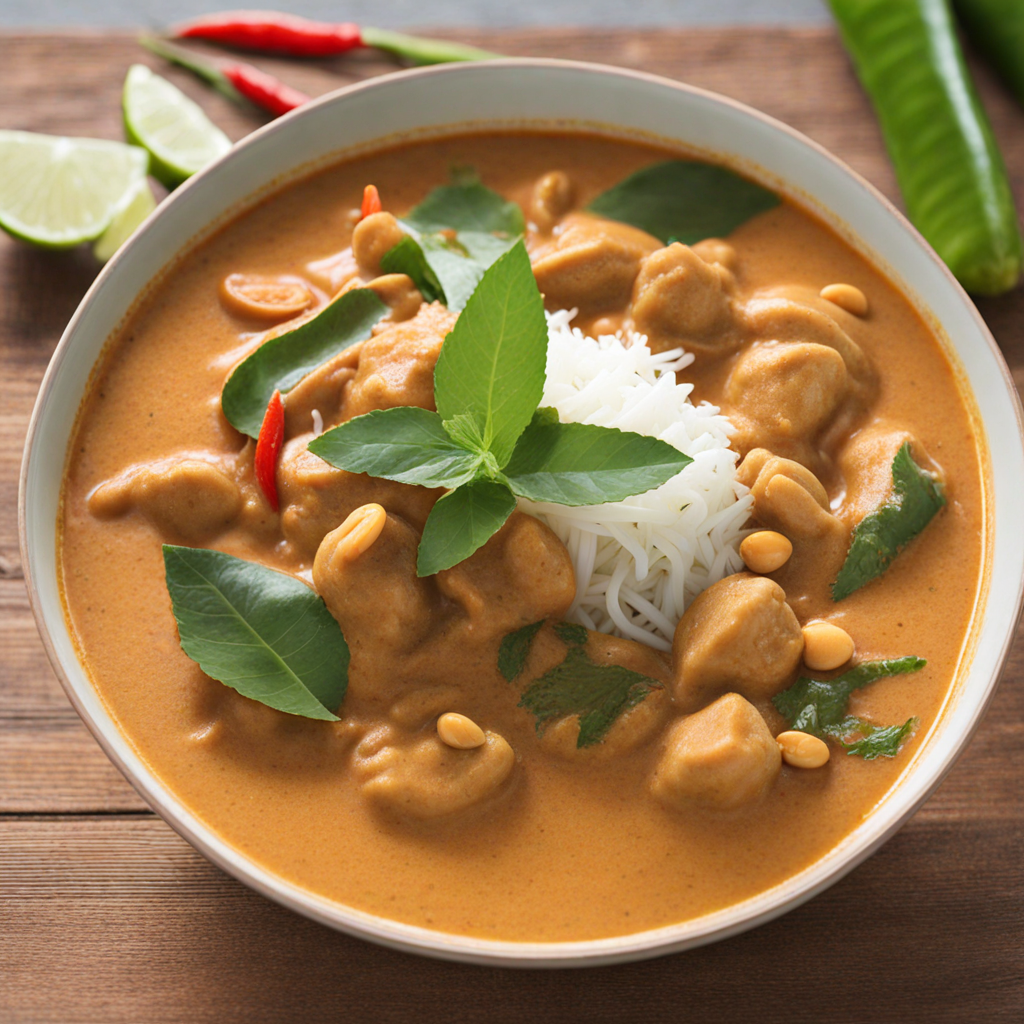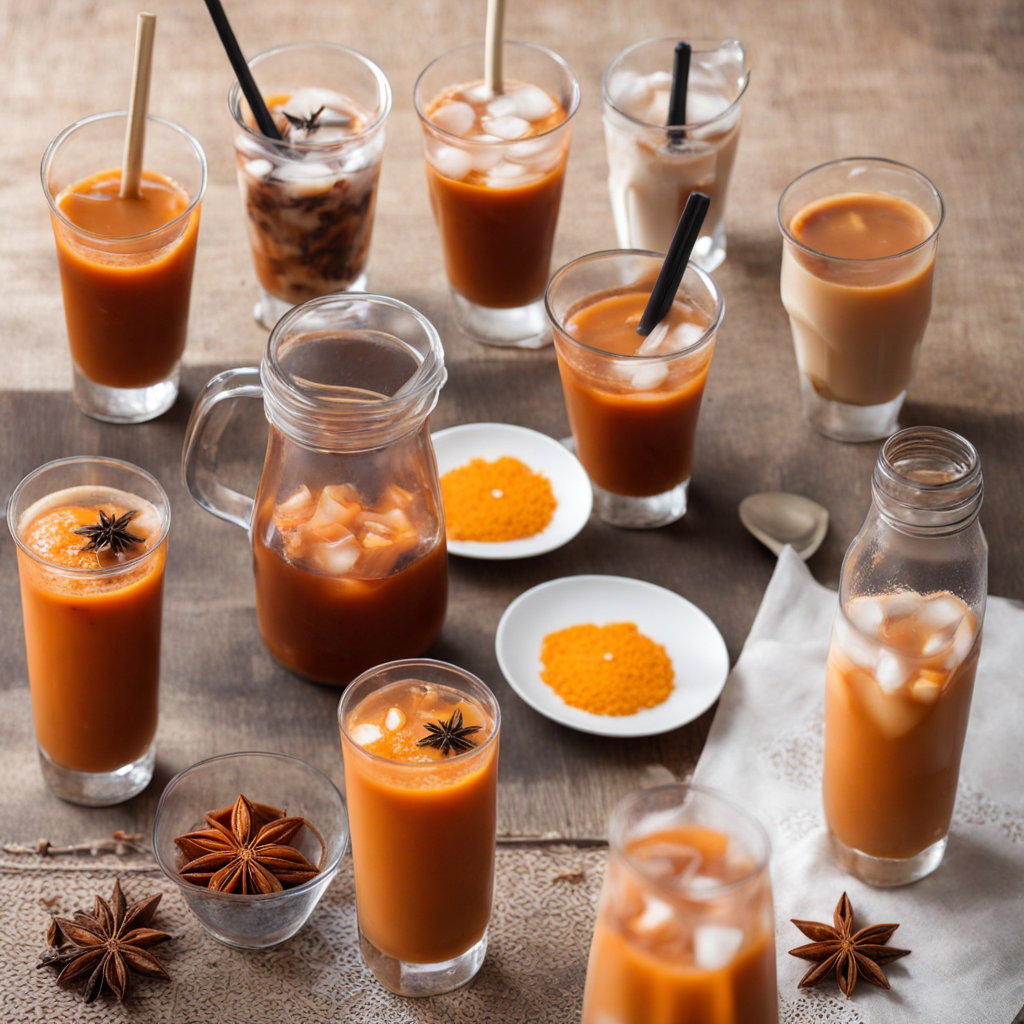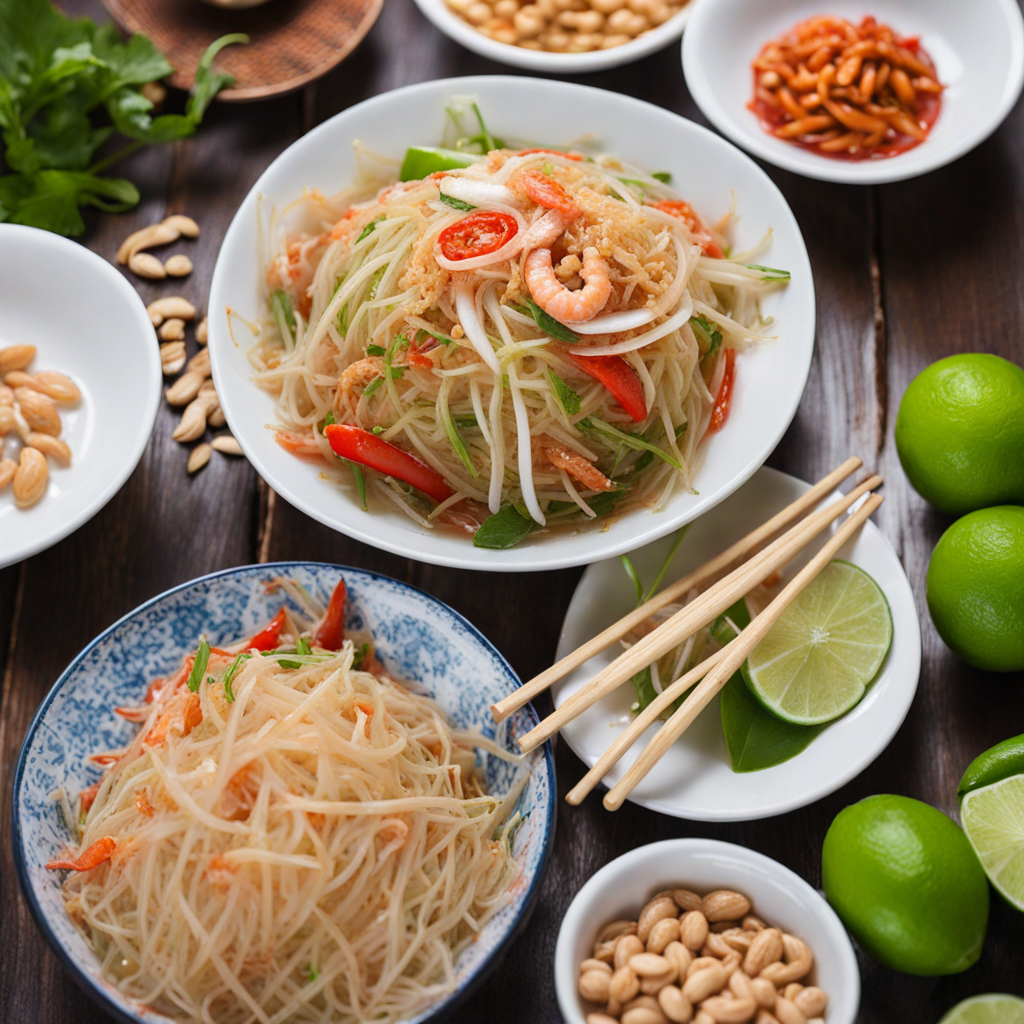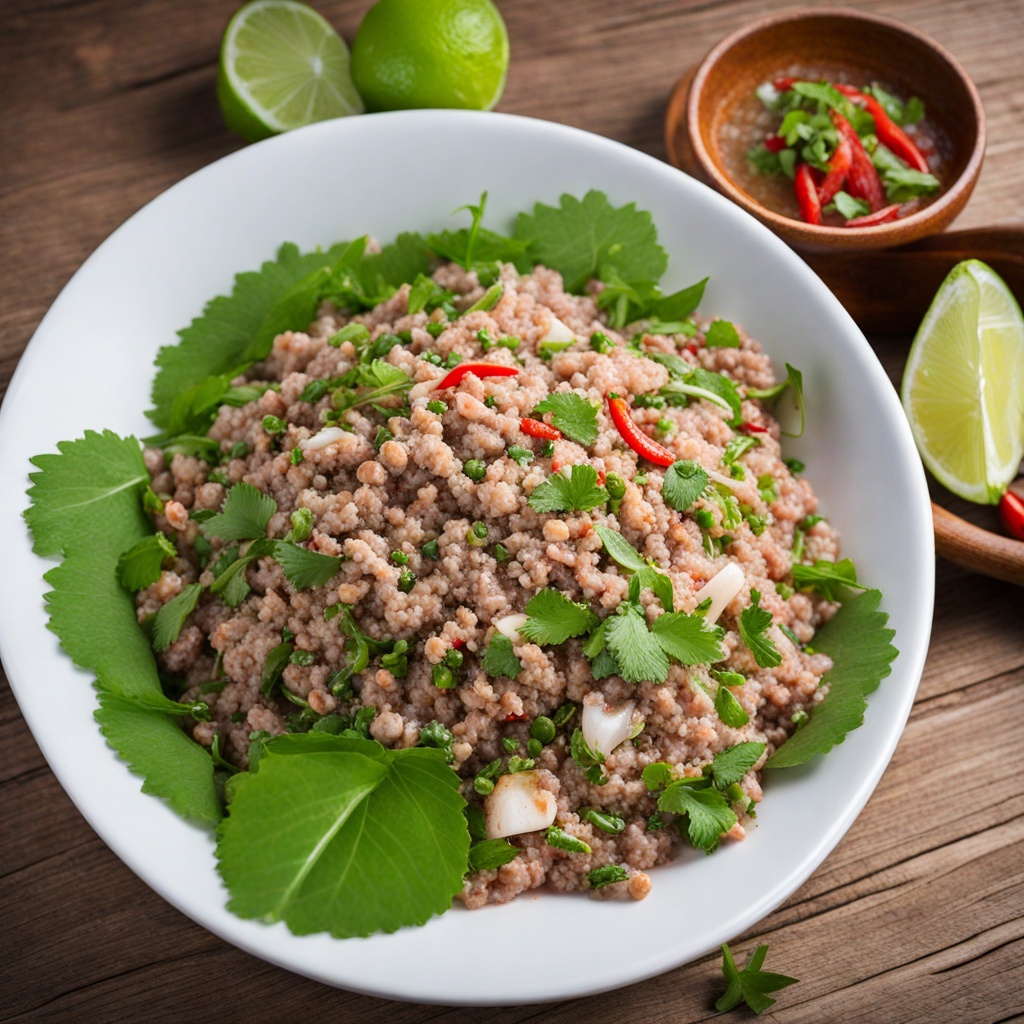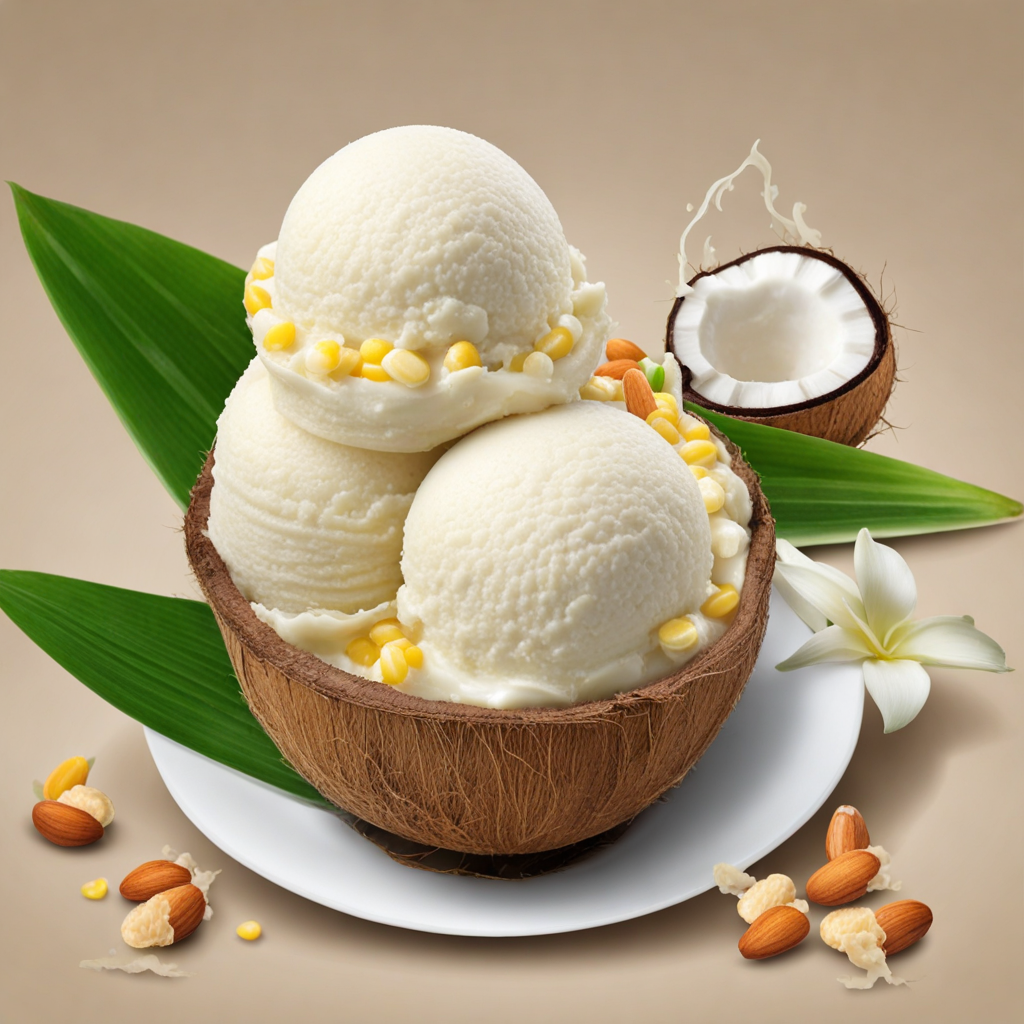Panang Curry
Panang Curry is a rich and aromatic Thai dish that captivates the senses with its vibrant flavors and creamy texture. At its core, this curry is made using Panang curry paste, a blend of ingredients such as red chilies, lemongrass, galangal, kaffir lime leaves, and shrimp paste. The paste is simmered with coconut milk, which adds a luxurious creaminess that balances the heat of the chilies. The result is a thick, luscious sauce that envelops the ingredients, making each bite a delightful experience. Traditionally, Panang Curry is prepared with beef, though chicken, pork, or tofu can also be used, making it versatile for various dietary preferences. The choice of protein is cooked until tender and then infused with the aromatic curry sauce, allowing the flavors to meld beautifully. Additionally, the dish is often garnished with fresh kaffir lime leaves and Thai basil, which contribute a burst of freshness that complements the richness of the curry. The combination of sweet, salty, and spicy notes creates a well-rounded profile that is distinctly Thai. When served, Panang Curry is typically accompanied by steamed jasmine rice, which helps to soak up the decadent sauce. Each mouthful delivers a harmonious blend of flavors, making it a comforting and satisfying dish. For those looking to explore new culinary landscapes, Panang Curry offers a unique taste experience that showcases the depth and complexity of Thai cuisine, inviting diners to savor its intricate flavors and textures.
How It Became This Dish
The Rich History of พะแนง: Thailand’s Iconic Curry Origins and Etymology The dish known as พะแนง (pronounced "phanaeng") is a rich and aromatic Thai curry that has garnered both local and international acclaim. Its origins can be traced back to the southern regions of Thailand, where the confluence of diverse cultures has given rise to a unique culinary landscape. The term “พะแนง” itself is thought to derive from the Malay word “kekal,” which refers to a thick substance, indicative of the dish’s creamy consistency. Historically, the use of curry in Southeast Asia can be linked to Indian influence, which permeated the region through trade routes and cultural exchanges that began over a thousand years ago. Thai cuisine, however, adapted these influences, creating a distinct style that emphasized fresh herbs, spices, and unique flavor profiles. The introduction of coconut milk, a staple in Thai cooking, transformed many curries, including phanaeng, into the creamy, rich versions we recognize today. Ingredients and Preparation At the heart of phanaeng is a base of red curry paste, which comprises a blend of ingredients such as dried red chilies, garlic, shallots, lemongrass, galangal, and shrimp paste. This medley is pounded together, traditionally using a mortar and pestle, to create a fragrant paste that forms the foundation of the dish. The use of fresh, local ingredients is essential in Thai cooking, and phanaeng is no exception. Once the curry paste is prepared, it is sautéed in coconut milk, which not only adds creaminess but also helps mellow the heat of the chilies. The dish is typically enriched with tender pieces of meat (commonly beef or pork), and it is often garnished with kaffir lime leaves, which impart a citrusy aroma. Peanuts, either crushed or whole, may also be sprinkled on top, enhancing the dish's texture and flavor. Cultural Significance Phanaeng is more than just a dish; it embodies the essence of Thai culture and communal dining. In Thailand, meals are often shared among family and friends, and phanaeng is a popular offering during gatherings and celebrations due to its rich flavors and satisfying nature. The dish is especially favored during festivals and special occasions, reflecting its status as a cherished culinary gem. Moreover, phanaeng serves as a bridge between various cultural influences. The melding of Thai techniques with Malay and Indian flavors represents the region's historical trade routes and migrations. As Thailand’s culinary reputation grew, phanaeng became a symbol of Thai cuisine on the global stage, showcasing the country's ability to harmonize diversity into a cohesive dish. Development Over Time As Thailand underwent significant changes through colonization, modernization, and globalization, so too did its culinary practices. The 19th and 20th centuries saw increased interaction with Western cultures, leading to the reimagining of traditional dishes. Phanaeng, while retaining its core characteristics, began to appear on menus in Thai restaurants around the world, often adapted to suit local tastes. In the 1980s and 1990s, as Thai cuisine gained popularity in the West, dishes like phanaeng were often adapted to reduce spice levels and enrich flavors to cater to a broader audience. This led to a redefinition of what authentic Thai food means, creating a dialogue between traditional preparations and modern culinary practices. Chefs around the world began experimenting with phanaeng, incorporating various proteins, vegetables, and even vegan alternatives, allowing the dish to evolve while maintaining its essence. Regional Variations While the classic phanaeng is predominantly found in central Thailand, regional variations have emerged that reflect local ingredients and tastes. In southern Thailand, for instance, the use of seafood is more prevalent, with fresh fish and shellfish often substituted for meat. Northern Thai versions may incorporate unique herbs and spices that are locally sourced, further diversifying the dish. Additionally, the interpretation of phanaeng can vary between restaurants and home kitchens. Some cooks may prefer a thicker, more concentrated sauce, while others may opt for a lighter consistency. The choice of protein can also vary, with chicken or tofu being popular alternatives to traditional beef or pork. Modern Trends and Global Influence In recent years, the global culinary landscape has experienced a surge in interest in authentic and artisanal foods. This has led to a resurgence of traditional Thai cooking methods, with chefs emphasizing the importance of using fresh, sustainable ingredients. Home cooks are also becoming more adventurous, experimenting with phanaeng and other traditional dishes, often sharing their experiences on social media platforms. As Thai cuisine continues to evolve, phanaeng remains a staple that captures the hearts and palates of many. The dish’s versatility lends itself to creative reinterpretations, while its historical roots remind us of the rich tapestry of flavors and cultures that have shaped it over the centuries. Conclusion Phanaeng is not just a dish; it is a story—a narrative woven through time, culture, and geography. From its origins in the southern regions of Thailand to its rise as a beloved dish around the globe, phanaeng reflects the dynamic nature of food and its ability to connect people. As we savor each bite of this aromatic curry, we partake in a culinary journey that spans centuries, cultures, and communities, reminding us of the power of food to transcend boundaries and bring people together. Whether enjoyed in a bustling Bangkok street market or a cozy kitchen in the West, phanaeng remains a testament to the enduring legacy of Thai cuisine.
You may like
Discover local flavors from Thailand


